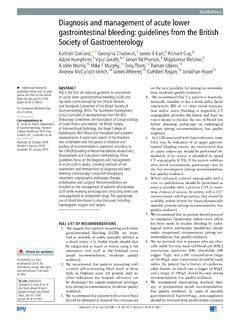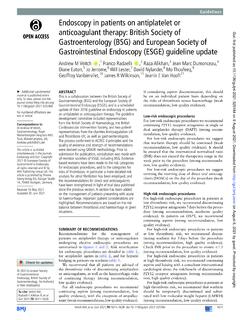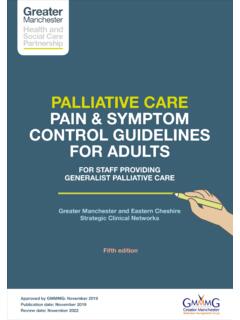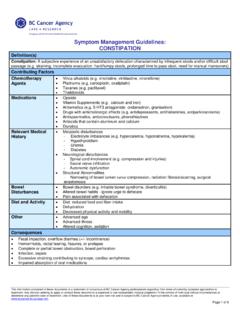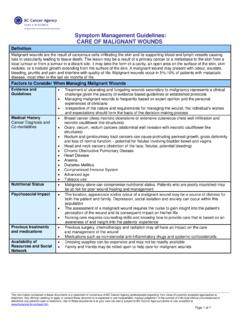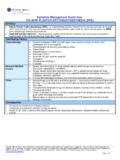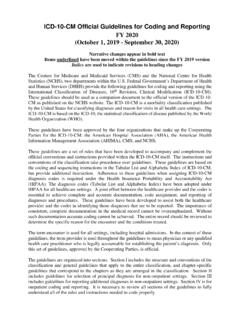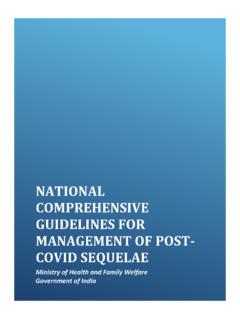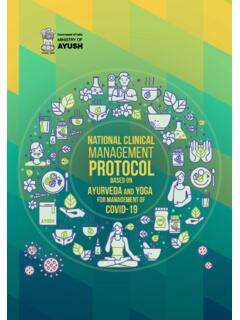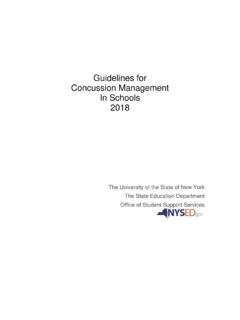Transcription of Guidelines The British Society of Gastroenterology/UK- PBC ...
1 1 HirschfieldflGM, et al. Gut 2018;0:1 27. British Society of Gastroenterology/UK- PBC primary biliary cholangitis treatment and management guidelinesGideon M Hirschfield,1,2,3 Jessica K Dyson,4,5,6 Graeme J M Alexander,7,8 Michael H Chapman,9 Jane Collier,10 Stefan H bscher,3,11 Imran Patanwala,12,13 Stephen P Pereira,7,8,9 Collette Thain,14 Douglas Thorburn,7,8 Dina Tiniakos,5 Martine Walmsley,15 George Webster,9 David E J Jones4,5,6 ABSTRACTP rimary biliary cholangitis (formerly known as primary biliary cirrhosis, PBC) is an autoimmune liver disease in which a cycle of immune mediated biliary epithelial cell injury, cholestasis and progressive fibrosis can culminate over time in an end-stage biliary cirrhosis. Both genetic and environmental influences are presumed relevant to disease initiation.
2 PBC is most prevalent in women and those over the age of 50, but a spectrum of disease is recognised in adult patients globally; male sex, younger age at onset (<45) and advanced disease at presentation are baseline predictors of poorer outcome. As the disease is increasingly diagnosed through the combination of cholestatic serum liver tests and the presence of antimitochondrial antibodies, most presenting patients are not cirrhotic and the term cholangitis is more accurate. Disease course is frequently accompanied by symptoms that can be burdensome for patients, and management of patients with PBC must address, in a life-long manner, both disease progression and symptom burden. Licensed therapies include ursodeoxycholic acid (UDCA) and obeticholic acid (OCA), alongside experimental new and re-purposed agents.
3 Disease management focuses on initiation of UDCA for all patients and risk stratification based on baseline and on-treatment factors, including in particular the response to treatment. Those intolerant of treatment with UDCA or those with high-risk disease as evidenced by UDCA treatment failure (frequently reflected in trial and clinical practice as an alkaline phosphatase > upper limit of normal and/or elevated bilirubin) should be considered for second-line therapy, of which OCA is the only currently licensed National Institute for Health and Care Excellence recommended agent. Follow-up of patients is life-long and must address treatment of the disease and management of associated SummARyPrimary biliary cholangitis (PBC) is a chronic auto-immune liver disease.
4 It continues to have a burden of morbidity and mortality that spans both the consequences of a sometimes progressive biliary injury, alongside a symptom profile notably encom-passing pruritus, sicca complex, fatigue, abdominal discomfort and arthralgias/bone pain. UK-PBC and the British Society of Gastroenterology (BSG) have partnered to develop a comprehensive guideline document to provide detailed advice and recom-mendations on the best approaches to the manage-ment of the disease. A series of recommendations and audit standards are proposed to ensure that patients are offered timely licensed therapy (ursode-oxycholic acid (UDCA), obeticholic acid (OCA)) in addition to being actively managed for symptoms as well as complications of progressive liver brief its key recommendations, based on the GRADE classification system (Strong/Weak; quality of evidence: High/Moderate/Low/Very low), are:1.
5 The presence of antimitochondrial antibodies (>1 in 40) or highly PBC-specific antinu-clear antibodies, in the appropriate context of cholestatic liver biochemistry, without alterna-tive explanation, is usually sufficient for confi-dently reaching the diagnosis of PBC (Strong; High).2. All patients with PBC should be offered structured life-long follow-up, recognising that different patients have different disease courses and may require different intensity of follow-up (Strong; Moderate).3. Risk assessment should evaluate disease severity and activity at baseline and on treat-ment. We recommend a combination of serum liver tests (to identify those with an elevated bilirubin, a platelet count <150 or biochem-ical disease activity on treatment), imaging (liver ultrasound to identify overt cirrhosis and splenomegaly; transient elastography to iden-tify increased liver stiffness) and recognition of young age at disease onset (<45 years) and male sex (Strong; Moderate).
6 4. To identify those at greatest risk of disease progression, we recommend that all patients have individualised risk stratification using biochemical response indices following 1 year of UDCA therapy (Strong; High). We suggest that UDCA treated patients with an alkaline phosphatase (ALP) > x upper limit of normal (ULN) and/or elevated bili-rubin <2 x ULN represent a group of high-risk patients in whom there is randomised controlled trial evidence for the addition of second-line therapy (Weak; Moderate).5. We recommend oral UDCA at 13 15 mg/kg/day is used as the first-line pharmacotherapy in To cite: Hirschfield GM, Dyson JK, Alexander GJM, et al.
7 Gut Epub ahead of print: [please include Day Month Year]. numbered affiliations see end of toProfessor Gideon M Hirschfield; g. hirschfield@ bham. ac. ukReceived 11 September 2017 Revised 22 January 2018 Accepted 23 January 20182 Hirschfield GM, et al. Gut 2018;0:1 27. patients with PBC. If tolerated, treatment should usually be life-long (Strong; High).6. In patients with inadequate response to UDCA (or UDCA intolerance) as defined by ALP > x ULN and/or elevated bilirubin <2 x ULN, the addition of OCA has been associated with improvements in biochemical surrogates of disease activity reasonably likely to predict improved outcomes. We therefore recommend, in keeping with the NICE evaluation of OCA, that the addition of OCA for patients with an inadequate response to UDCA, or intol-erant of UDCA, is considered.
8 We recommend dose adjust-ment in patients with advanced liver disease as per the drug label (Strong; Low).7. We recommend all patients should be evaluated for the presence of symptoms, particularly fatigue and itch. Clini-cians should recognise that severity of symptoms does not correlate with stage of disease (Strong; Moderate).8. True overlap with autoimmune hepatitis is probably rare and we suggest that, when suspected, liver biopsy with expert clinicopathological review is needed to make the diagnosis and guide treatment (Strong; Moderate).9. We recommend that patients with PBC should be offered the chance to seek support from patient support groups (Strong; Moderate).10. We recommend that clinicians caring for patients with PBC should consider introducing clinical audit tools to docu-ment and improve the quality of care delivered to patients (Strong; Low).
9 InTRoduCTionPrimary biliary cholangitis (formerly known as primary biliary cirrhosis, PBC), is a life-long autoimmune cholestatic liver disease that is a rare but important cause of chronic liver disease. More than 15 000 individuals in the UK live with the risks and consequences of chronic biliary inflammation. New advances in clinical disease understanding have highlighted individual risk, and demonstrated the value to patients of approaches to risk stratification. At present, care remains predominantly led by secondary and tertiary care physicians, who confirm diagnosis, initiate therapy and coordinate ongoing follow-up. These guide-lines are targeted predominantly towards those gastroenterolo-gists and hepatologists leading the care of patients with PBC.
10 However, in addition they will be of value to nurses, primary care physicians and those more broadly involved in patient care, as well as patients themselves. The Guidelines have been devel-oped as a partnership between the BSG and UK-PBC, a Medical Research Council (MRC)-funded National Institute for Health Research (NIHR) Rare Disease adopted, stratified medicine initiative in PBC (www. uk- pbc. com). The guideline development has followed the BSG established pathway (http://www. bsg. org. uk/ images/ stories/ docs/ clinical/ Guidelines / general/ bsg_ guide-lines_ advice_ document_ may2016. pdf),1 and includes develop-ment of a broad membered cholestasis Guidelines Development Group, including patient impact for patients living with PBC reflects the risk of development of advanced cirrhotic and portal hypertensive liver disease as well as marked effects on quality of life (QoL) from associated symptoms.


